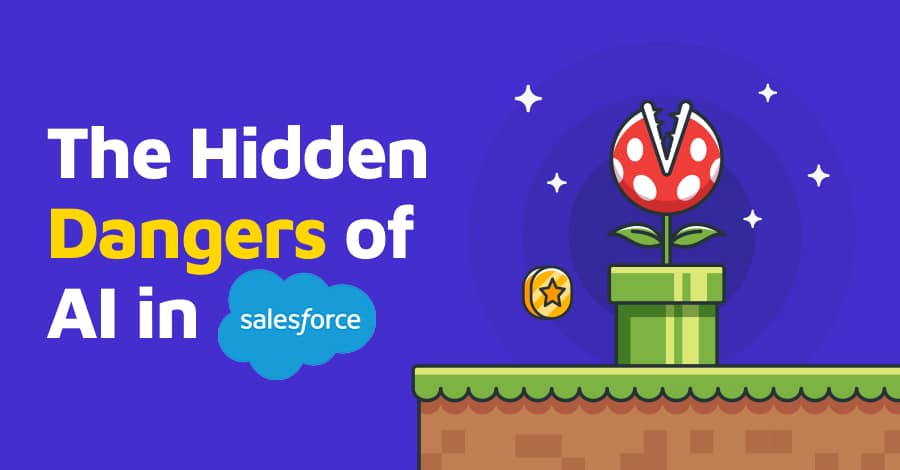Table of Content
As Salesforce specialists learn , AI can propose and even create Flows, Validation Rules, Formula Fields, and Apex triggers. Delivery speeds up and manual effort goes down. The risk is that most responses lack org-level context. Without full metadata awareness – dependencies, order of execution, permissions, and cross-system touchpoints – they introduce logic that looks fine in isolation but collides in production.
What can break:
- Duplicate updates and recursion
- Sharing and FLS regressions
- Side effects in Apex and async jobs
- Corrupted downstream integrations
Bottom Line
AI without context raises change risk. Guard every AI-assisted change with metadata impact analysis and targeted regression tests before it reaches production.
What You’ll Learn
- Why metadata context is non‑negotiable for safe Salesforce changes
- Common failure modes when AI acts without context
- Observable warning signs that AI has gone wrong
- A practical guardrail checklist before letting AI modify Salesforce
- How Panaya AI reduces risk with impact analysis, test automation, and explainability
- The KPIs leaders should track to prove improvement
Why Is Metadata Context the Backbone of Salesforce Integrity?
Metadata context: what matters
- It’s the full picture of your org – object schemas and relationships, order of execution across Flows, legacy Process Builder and Apex triggers, validation rules, permission models like FLS and sharing, managed packages, and connected systems.
- If an AI builder doesn’t parse this graph, it can’t anticipate how a simple change collides downstream. The highest risk surfaces across record-triggered Flows and Apex, where execution order governs side effects.
Security in the AI era
- Treat autonomous agents and copilots as privileged automation that must follow least-privilege access, continuous monitoring, and testing before they create or promote changes.
- Align with Salesforce guidance on securing agents and uphold a shared responsibility model between platform owners and AI tooling.
What Can Happen When AI Acts Blindly?
When AI ignores metadata, changes that look correct in isolation can collide in production.
Real‑life failure modes:
- Conflicting Flows or recursive updates on the same object/event
- Broken validation or sharing logic → data exposure or blocked saves
- Dirty data that corrupts integrations or analytics
- Corrupted integrations (e.g., writing to managed package fields/external IDs)
Real‑world scenario:
AI creates a new Opportunity Flow to auto‑assign products and set Closed Won when an amount threshold is met, without detecting an existing Process Builder and after‑update Apex that handle pricing and schedules. The result is duplicate updates, recursive saves, and a downstream ERP posting revenue twice. Finance reports are wrong; nightly jobs fail.
What Are The Warning Signs AI Has Gone Wrong?
- Spikes in Flow/Apex errors
- Look for sudden increases in FLOW_ELEMENT_ERROR, unhandled Apex exceptions, and governor limit violations. Review debug logs and Flow error emails; check if failures cluster by object/triggered event. (Order‑of‑execution conflicts are a common root cause.)
- Data drift & permission anomalies
Picklist values, stages, or currencies shift unexpectedly; users see fields or records they shouldn’t (FLS/sharing regressions). - Reports changing unexpectedly
KPI totals move without a matching business event; investigate recent automation changes first. - Async queue overload
Surges in Platform Events, Batch, Queueable, or Scheduled jobs; look for loops or mass reprocessing triggered by new logic.
What Are The Minimum Guardrails Before Letting AI Modify Salesforce?
Actionable checklist:
- Metadata‑aware diff + dependency map for every proposed change
- Pre‑deploy impact analysis across Flow, Apex, Validation, Permission Sets, Integrations, Managed Packages
- Automated regression suite scoped to predicted impact
- Audit logging & rationale (why the AI proposed a change; who approved it)
- Sandbox testing with seeded data (production‑like subsets & masked PII)
How Does Panaya Reduce AI Risk? The 3 Core Layers
Safely. Intelligently. Audibly. Panaya can apply AI before and after deployment to prevent collisions, validate outcomes, and provide a human‑readable rationale suitable for governance and audit.
AI Impact Analysis
Maps dependencies from your metadata and customizations, predicting which objects, Flows, Apex classes, validations, and integrations a change will touch. Flags collision risks such as duplicate triggers, field‑update loops, and permission regressions.
AI‑Powered Test Automation
Generates and maintains regression suites aligned to the predicted impact. Self‑heals locators and steps when UI or metadata changes. Extends beyond Salesforce to connected SAP and Oracle business flows to validate end‑to‑end outcomes.
AI Explain
Produces human‑readable reasoning for risk hotspots, test selection, and failures. Accelerates root‑cause analysis and sign‑off with clear evidence.
Governance value: risk scoring per change, full traceability from requirement → impact → test → release decision.
Implementation Blueprint: Safe AI for Salesforce
The path to safe AI changes is straightforward: connect, analyze, review, test, and promote; with evidence.
7 steps:
- Connect Salesforce environments and extract metadata
- Run Panaya Impact Analysis on AI‑generated or AI‑assisted changes , use AI Explain to review results
- Review dependency map & collision warnings
- Create regression suite for the impacted scope
- Execute tests on a seeded sandbox as a part of Salesforce Devops Test Center Integration with Panaya test automation
- Remediate conflicts or missing guardrails; rerun until quality gate is green
- Promote with an evidence pack for CIO and audit sign‑off
What are the KPIs Salesforce Leaders can track to Measure Improvement?
- Defects escaping to production per release
- Time to detect & fix change collisions
- % of changes with completed impact analysis
- Automated test coverage on the impacted scope
- Mean time to root cause using AI Explain
Conclusion: The Real Risk Isn’t AI; It’s Contextless AI
AI that “acts blind” creates risk. AI that understands metadata prevents it. Panaya gives your AI both eyes and guardrails, so your releases are safer, faster, and auditable.
Frequently Asked Questions
